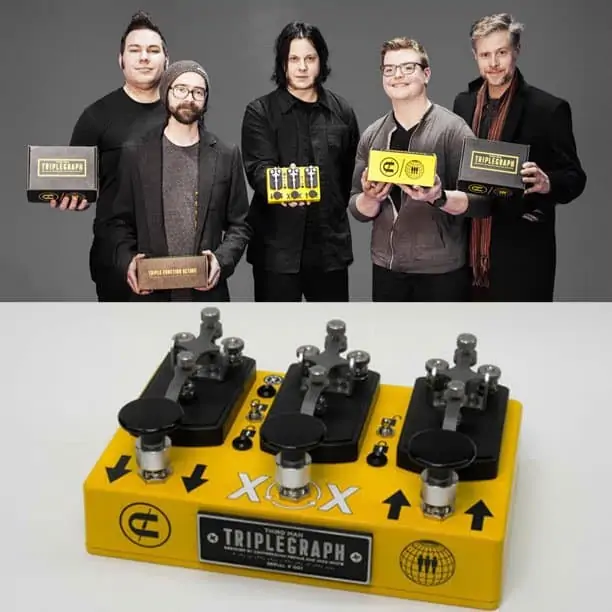
In a world where meeting has become unexpectedly challenging, the story of the Triplegraph may sound like a tale from another era. A time when musical instrument makers would meet (unmasked!) at crowded conventions where devices would change hands without undergoing layers of disinfectant.
It was a device exchange three Summer NAMMs ago (2016 edition) that triggered the beginning of this story: A weird-looking stutter/killswitch pedal made its way into Jack White’s Nashville office. Upon opening the box it came in, the guitarist’s neurons started a frantic activity – probably due to the device’s yellow color and its unconventional footswitch. Back burner ideas took a new, more exciting shape. A collaborative creative process had begun.
Four years later, that process has reached its end. After seeing the results, we were very curious to know more details about how this weird beast of a pedal came to see the light of day. Coppersound’s Design Director Jordan Collins shed some light on the matter.
How did the collaboration with Jack White start? How did he find out about your work and contact you?
In 2016, we did our first Summer NAMM show in Nashville. Alex mentioned to me that Jack White’s headquarters, Third Man Records, was located right near where we were staying. I suggested that we make a custom Telegraph Stutter and drop it off there for Jack as a gift. Alex replied, “Sure! But we have to make it yellow.” We dropped the pedal off and about 45 minutes later, received a call that Jack received the pedal, really liked it, and was interested in speaking to us about an idea that he had. This was during the chaotic first day at NAMM, so we were scrambling around trying to get cell reception while presenting and doing interviews at our booth. We managed, though! Finally, we were able to contact him and set up a meeting.
Did Jack have already a vision for an octave pedal when he reached out or was that the result of a creative joined process?
He did, yes. When we were first approached by Third Man, Ben Swank (a co-owner of Third Man Records) gave us a photoshopped picture of a pedal that featured three of our telegraph keys. He said that Jack wanted each key to have a different function: octave down, killswitch, and octave up. There’s actually a picture of this in the 130+ page book I’ve designed that comes with each Triplegraph documenting the four-year journey. Very cool to look back and see how things evolved!
So, although it’s built around your Telegraph pedal, this is Jack’s first pedal that’s not just a mod of an existing design, correct?
Yes, this is the first Third Man pedal that has been designed and engineered from the ground up with Jack. When he brought us the idea for the pedal, we knew that it was going to be A LOT of work, but we wanted to do the work. It was an honor and dream come true to bring this concept to life with him and Third Man.
How was the process of getting to the final version of it?
Jack knew exactly what he wanted for an octave pedal, and we are so grateful that he trusted us to do it. He is truly one of the smartest and nicest people I’ve ever had the privilege of working with. One aspect of this project that I really loved was that when working together, he’s open to trying new ideas we had and is always willing to listen and build on them. He used the Triplegraph in the studio during the recording of ‘Help Us Stranger’ with the Raconteurs and also road-tested the pedal extensively all over the world. It was an absolutely incredible experience getting to design this new pedal with him.
Are the octave-up and down effects in the Triplegraph based on an existing design or did you create them from scratch?
The octaves were completely designed and coded from scratch, and are powered digitally through a high-power DSP engine. This allows for spotless tracking and zero-latency. Also, the octaves themselves are nothing short of the highest quality.
What advantages does the Triplegraph’s key foot control have over regular footswitches?
The Triplegraph keys allow you to trigger effects much faster with your hand or foot (in momentary mode) than you could with just regular switches. In latching mode, you can trigger the octaves to stay on, independently with our ‘Loctave’ toggle switches. Also, the new hardware on the Triplegraph was engineered and designed for endless abuse, whether its in the studio or on stage. Jack road-tested the Triplegraph on tour and he’s very hard on his gear, so we know we had to make it indestructible to hold up to his standards. We achieved this through designing our own proprietary hardware, comprised of thick, stainless steel and aluminum. The pedal has a special aesthetic and combines the latest technology with some old-school, mechanical features. It’s a nice blend of the two worlds.
The Triplegraph can be purchased here.
Check out all the video demos of the Coppersound/Third Man Triplegraph.






















